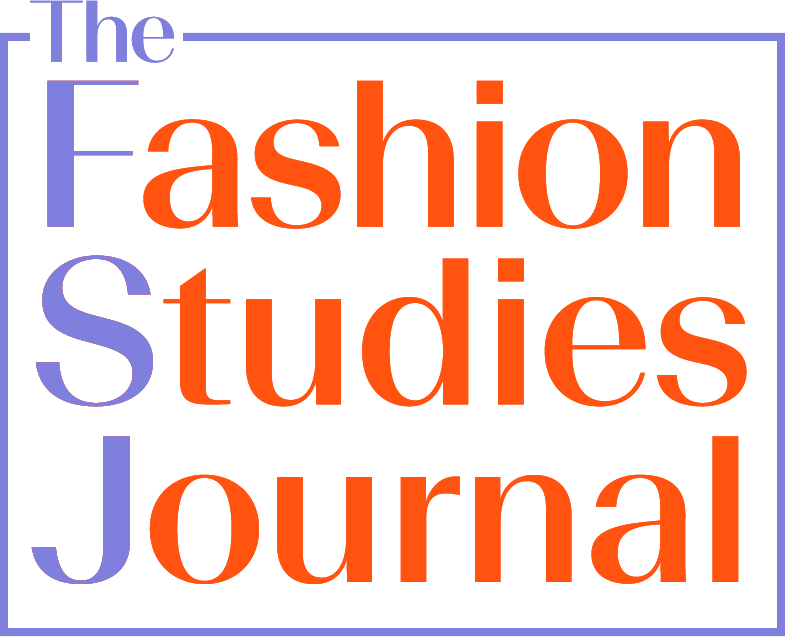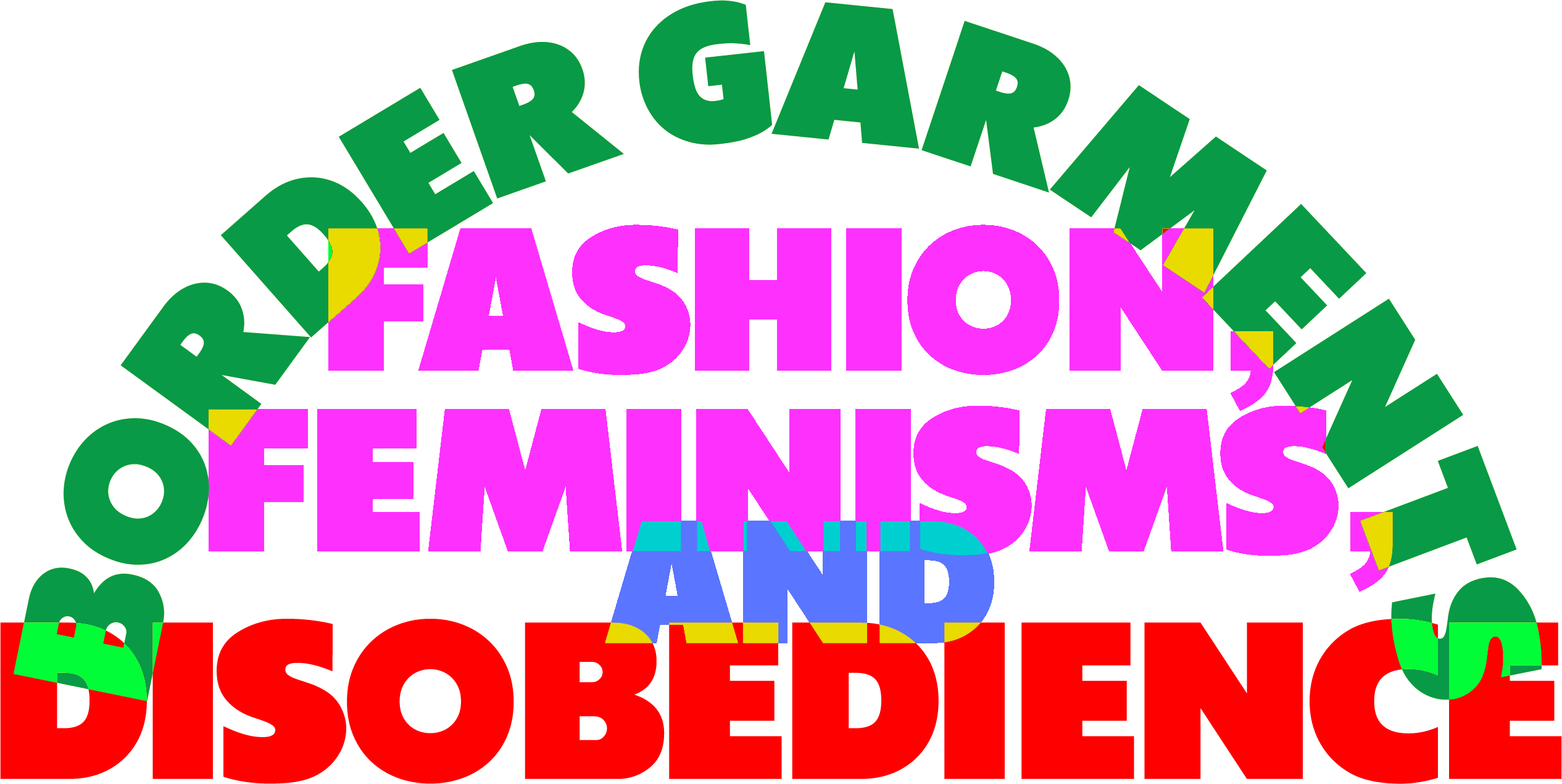Special Issue Edited by The Border Creatures: Loreto Martinez, Tamara Poblete, Ellen Sampson, and Karen van Godtsenhoven
 The Border Creatures
The Border CreaturesTABLE OF CONTENTS
- Letter from the Editors
By The Border Creatures
-
Queer Fashion Against Pinkwashing: An Interview with Trashy
By Roberto Filippello
- Embracing the Stigma: “Freedom Cunts” and Their Destigmatization and Empowerment
By Hennessy Eileen
- Between the Public and Private: Transformative Agency of Wearable Forms of Protest
By Lucia Cuba
Versión en castellano - Deviant Dress Codes: Negotiating Spaces in the Sartorial Sculptures of Carlos Villa and Leeroy New
By Weiqin Chay
- JIWASA / NOSOTRAS
Balbucear gritando / Gritar balbuceando
By Movimiento Maricas Bolivia
-
Clothing and Adornment as Resistance:
Disobedient Bodies and Aesthetic Expressions in Paraguay
By Jazmín Ruiz Díaz Figueredo & Kira Xonorika Versión en castellano - Fashion as Political Statement in Post-Revolutionary Iran
By Azadeh Fatehrad
- The Clothes of Violence 1973-1990
By Pía Montalva
Versión española - Made in the Philippines: An Interview with Vintage Fashion Shop Glorious Dias
By Bianca García
-
Visual Narrative Memories from the Gender Border: Performances of Dressed Bodies
By Violet Arvin Casoni, Carolina Brandão Piva,
& Luciene de Oliveira
Versão em português - Pain at the Border: The Feminization and Exploitation of Textile Work in Mexico
By Mariana Parra González
Versión española -
A Visual Script on Borders and Borderline Garments
By Anita Puig & Giancarlo Pazzanese
Versión española
Letter from the Editors
We write this introduction to “Border Garments: Fashion, Feminisms and Disobedience” just over two years after our first conversations about developing a special issue which addressed the surge of protests and uprisings against neoliberal patriarchal capitalism in Latin America. In light of new and ongoing crises in women’s rights across the globe, with daily news about state killings of women in Iran, and violence against women and LGBTQIA+ persons in Afghanistan, Russia, Syria, the USA, Qatar, Hungary and Poland, it has at times felt futile to focus on fashion and garments as a tool for disobedience. Yet the role of the dressed body as sites and catalysts of political resistance has never been more evident and we hope that however small, this issue can amplify subversive voices in the face of oppression across the world.
The title of this issue and its broader conceptual framework stem from Gloria E. Anzaldúa’s seminal text Borderlands/La Frontera: The New Mestiza, which examines the Latinx and Chicana experience through the lens of racism, colonialism, gender and class identity. Anzaldua writes about the border between the US and Mexico as:
“una herida abierta (an open wound) where the Third World grates against the first and bleeds — the lifeblood of two worlds merging to form a third country — a border culture. Borders are set up to define the places that are safe and unsafe, to distinguish us from them. A border is a dividing line, a narrow strip along a steep edge. A borderland is a vague and undetermined place created by the emotional residue of an unnatural boundary. It is in a constant state of transition. The prohibited and forbidden are its inhabitants.” [1]
Borderlands, teeming with transition, as an in-between space of resistance against control, are thus also full of potential. Similarly, garments, with their potential for transmutation from their artistic-objectual condition to their ability to transmit a specific discourse, can generate through their bodily actions crises of meaning around coloniality, sex/gender, class and race.
 Figure 1. Gloria Anzaldúa by Annie F. Valva
Figure 1. Gloria Anzaldúa by Annie F. ValvaThe use of garments as means for counter-hegemonic ideas is certainly not new and this special builds on the already extensive academic literature on the intersections of dress practices and politics including the work of Djurdja Bartlett (East), Regina Roots (Latin America) and Pía Montalva (Chile) and into dress and decoloniality, such as the work of Sarah Cheang (Asia) and Erica de Greef (Africa). [2] The demonstrations in which clothing and protest have been allies in political-social processes have been too multiple to list but include the Incroyables, the Bloomerites, the Suffragettes, the Aesthetic movement and its LGBTQIA symbols, the Zoot suit, the miniskirt, and the dress code of the Black Panthers. More recently the Pussyhat movement, female celebrities dressed in black at the Golden Globe Awards in honor of Time’s Up / #MeToo, female politicians wearing white in reference to Suffragettes, the use of clothing in Black Lives Matter protests and with women in Iran cutting their hair in solidarity with the deceased Mahsa Amini all highlight the ways that altering and politicizing one's appearance has become a medium to disrupt and critique hegemonic structures. [3] In building upon these texts this special issue seeks to make visible design and making processes, theoretical frameworks and activism experiences which emerge from and take place in countries that are often excluded from the “canon” of fashion studies. The articles in this issue come from and addresses experiences of clothing protest and resistance in Peru, the Philippines, Paraguay, Iran, Chile, Brazil, Singapore, Bolivia, Mexico and Palestine and through their works the authors highlight these territories as legitimate places of knowledge production.
The original impulse for this issue came from the courageous wave of protests in Chile and more widely in Latin America since 2018, which acted as beacons of liberation and hope in the global women's struggle. Both before, during and after the COVID-19 pandemic, numerous countries (in particular those across the Global South), saw a surge of protests and uprisings, against neoliberal patriarchal capitalism and oppression: interventions in the public space mainly by feminist collectives and gender-sex dissidents who put clothing at the center of their action strategies. Despite global the confinements of multiple lockdowns, these manifestations were not silenced, but instead resurfaced through social networks; prepondering a resignification of these garments, their materiality and the manual techniques associated with the female space (sewing, embroidery, knitting, etc.), where bonds of sisterhood are woven, and generational knowledge of hand work is disseminated. These new forms of protest have come to “produce” politics, or even to embody the political in performance and mass mobilization to the extent that feminist movements have marked the political agenda of the continent. This capacity of Latin American feminisms for action can be traced to the practice of a large-scale popular feminist movement that the Bolivian anarcho-feminist, María Galindo, has called “feminismo intuitivo” (intuitive feminism) in her last book Feminismo Bastardo. [4] According to Galindo, this is a type of feminism that doesn’t come from academic instruction, but from the great ability of women to read their own history and generate ruptures of a political nature. Galindo suggests that this feminism is, in effect, the one that is changing the patriarchal structures of society.
Taking the events of 2018 as a starting point and inspiration, this special issue brings together a diverse group of scholars to explore a dress practices which cross and recross borders spanning design, photography, making, reuse, artistic practice, and performance. These papers challenge the idea of clothing as something passive or decorative framing it instead as a powerful and political form of material culture which can both empower and do great harm. Starting with design and making, Roberto Filipello (Italy, Canada) interviewed the activist design collective Trashy about their design practice as resistance in the face of colonial and LGBTQIA+ oppression in Gaza. In “Clothing and Adornment as Resistance: Disobedient Bodies and Aesthetic Expressions in Paraguay,” Jazmín Ruiz and Xonorika Kira (Paraguay) bring us closer to disruptive proposals in contemporary Paraguayan fashion, focusing on two brands that dismantle the binary order of gender: Deiv/Bassen and Baby Trauma. Bianca Garcia (Philippines) introduces us, in an interview, to the transformative community evolution of the work of the queer Filipino artist and designer Jodinan Aguillon and the profound impact that the precariousness of life, the Balikbayan diaspora and the pandemic had on this process. Whilst Mariana Parra (Mexico) interviews border workers about the circumstances in which they produce garments for major fashion brands, testifying to the brutal impact that precariousness, marginalization and exploitation imposed by the current capitalist system, conditions required for its perpetuation.
Violet Arvin Casoni (Chile), Carolina Brandão Piva, and Luciene de Oliveira Dias (Brazil) delve into trans performativity, situating themselves in the dictatorial contexts of Chile and Brazil through the photographic work of the artists Paz Errázuriz and Magdalena Schwartz and the artist Vasco Szinetar. From Latin America, Maricas Bolivia (Bolivia) approaches identity, sexuality and proper name from an indigenous decolonial position in the visceral poem-manifesto “Balbucear gritando / Gritar babbuceando.” Thinking about protest Lucia Cuba (Peru) proposes the activation of clothing as a political device in daily life in her production “Vestibles para/por la protesta,” a series of garments that, from the personal point of view of everyday life, makes visible and confronts complex social problems. The second article on protest by Eileen Hennessy “Embracing the Stigma: ‘Freedom Cunts’ and Their Destigmatization and Empowerment” was withdrawn from the issue over concerns for the author’s personal safety in the face of government tracking and censorship. The blank page symbolizes our tribute to the courage and strength of authors whose voices are currently being censored. Pía Montalva (Chile), in turn, in an exhaustive archival investigation, examines the role of clothing within the chain of production of violence in the Chilean civic-military dictatorship of Augusto Pinochet (1973 to 1990), specifically, the who occupied two garments used to disable the body: the bandage and the overalls.

Figure 2. Maria Galindo by EDITORIAL MANTIS
Weiqin Chay (Singapore), analyzes the work of Leeroy New and Carlos Villa (migrant Filipino artists in the US) problematizing from fashion studies the role of clothing in the representation of diasporic identities. The moving photographic essay by Artist Azadeh Fatehrad (UK/Iran), delves us into the complexities of contemporary Iranian feminism through the relationship of women with the female Muslim veil in the 21st century. Anita Puig (Chile) and Giancarlo Pazzanesse (Chile/Italy/Netherlands) close by problematizing the very concept of border both in the proposed writing format and in the different cases they address, all focused on the intersection between the wearable and the border.
As editors, working with and amending others' words, we were conscious of the role of language as a tool for disobedience and liberation. In the chapter “How to Tame a Wild Tongue”, Anzaldua describes the process of being alienated from her mother tongue, and how, by keeping her tongue wild, she won’t let closing linguistic borders control her language. She continues to describe other “disciplining” instances where language purists try to hammer out the “border language” she shares with many Latinx immigrants. Anzaldúa shows the connection someone’s language has to their identity, and how the two go hand in hand. Given the dominance of the English language as the lingua franca of fashion studies, and the colonial histories and legacies of this dominance, we chose to publish this issue in dual language giving authors the option to write and publish in their mother tongue. as a feminist practice in the face of linguistic, patriarchal oppression. We want to thank the translator who made this possible, Alejandra Szczepania for the Spanish texts and the universities of Ghent (Belgium) and Northumbria (UK) for their generous funding.
In the process of editing this journal, we were confronted by the realities of censorship and personal danger to people who speak up. A contributing author asked to be removed from the issue because of government tracking and censorship dangers. We dedicate an empty page to this author and all other authors who might have wanted to contribute, but whose political situation makes it too dangerous to speak out. We stand in solidarity with those whose voices cannot (yet) be heard and remain hopeful for the future.
In conclusion, we would like to thank the courageous and disobedient authors for their contributions, the FSJ team for their patience, generosity, openness and hard work in making this issue a reality, and Sultana Bambino for her electric creativity and willingness to create a special graphic identity for this “Border Garments: Fashion, Feminisms and Disobedience” issue, which we are so proud of.
With this issue, we hope to connect the authors with new readers and inspire cross-cultural communities of enquiry, exchange and disobedience.
In solidarity and defiance,
The editorial team
As editors, working with and amending others' words, we were conscious of the role of language as a tool for disobedience and liberation. In the chapter “How to Tame a Wild Tongue”, Anzaldua describes the process of being alienated from her mother tongue, and how, by keeping her tongue wild, she won’t let closing linguistic borders control her language. She continues to describe other “disciplining” instances where language purists try to hammer out the “border language” she shares with many Latinx immigrants. Anzaldúa shows the connection someone’s language has to their identity, and how the two go hand in hand. Given the dominance of the English language as the lingua franca of fashion studies, and the colonial histories and legacies of this dominance, we chose to publish this issue in dual language giving authors the option to write and publish in their mother tongue. as a feminist practice in the face of linguistic, patriarchal oppression. We want to thank the translator who made this possible, Alejandra Szczepania for the Spanish texts and the universities of Ghent (Belgium) and Northumbria (UK) for their generous funding.
In the process of editing this journal, we were confronted by the realities of censorship and personal danger to people who speak up. A contributing author asked to be removed from the issue because of government tracking and censorship dangers. We dedicate an empty page to this author and all other authors who might have wanted to contribute, but whose political situation makes it too dangerous to speak out. We stand in solidarity with those whose voices cannot (yet) be heard and remain hopeful for the future.
In conclusion, we would like to thank the courageous and disobedient authors for their contributions, the FSJ team for their patience, generosity, openness and hard work in making this issue a reality, and Sultana Bambino for her electric creativity and willingness to create a special graphic identity for this “Border Garments: Fashion, Feminisms and Disobedience” issue, which we are so proud of.
With this issue, we hope to connect the authors with new readers and inspire cross-cultural communities of enquiry, exchange and disobedience.
In solidarity and defiance,
The editorial team
Notes: Letter from the Editors
[1] Anzaldúa, G. (2012). Borderlands / La Frontera: The New Mestiza. (4ta. Edición). San Francisco: Aunt Lute Books.
[2] Roots, R. (2014). “Fashion, Agency and Policy” (Section V), in Root, R, De la Haye, A, Entwistle, J, Black, S, Rocamora, A and Thomas, H. (Eds.) The Handbook of Fashion Studies. London: Bloomsbury Academic.
[3] “From heads, legs and underarms, to wigs and beards, and everything in between, the presentation, manipulation and daily experience of human hair plays a central and dynamic role within fashion, self-expression and the creation of social identity.” Cheang, S. (2008). Hair: Styling, Culture and Fashion. Berg Publishers.
[4] Galindo, M. (2021) Feminismo Bastardo. La Paz: Mujeres Creando.
[5] Sultana Bambino, the designer who created this issue’s visual identity, used Boldstrom type for the article headers, a font with a disobedient legacy of Black Panther newspapers and political posters.
Additional References
Cheang, S. (2021) “Section I (Introduction). Disruption in Time and Space”, in Cheang, S, De Greef, E and Yoko, T. (eds.) Rethinking Fashion Globalization. London: Bloomsbury Publishing, 17.
Cheang, S and Suterwalla, S. (2020) “Decolonizing the Curriculum? Transformation, Emotion, and Positionality in Teaching”, in Slade, T and Jansen, A. (eds.), Fashion Theory, Volume 24, (6) Decoloniality and Fashion, 879- 900. doi.org/10.1080/1362704X.2020.1800989
De Greef, E. (2020) “Curating Fashion as Decolonial Practice: Ndwalane’s Mblaselo and a Politics of Remembering”, in Slade, T and Jansen, A. (eds.) Fashion Theory, Volume 24, (6) Decoloniality and Fashion, 901-920. doi.org/10.1080/1362704X.2020.1800990
Montalva, P. (2013) Tejidos blandos: indumentaria y violencia política en Chile, 1973-1990. Santiago: Fondo de Cultura Económica.
Roots, R. (2010) Couture and Consensus: Fashion and Politics in Postcolonial Argentina. Minneapolis: University Of Minnesota Press.
Issue 15 ︎︎︎
Fashion & Southeast Asia
Issue 14 ︎︎︎
Barbie
Issue 13 ︎︎︎ Fashion & Politics
Issue 13 ︎︎︎ Fashion & Politics

